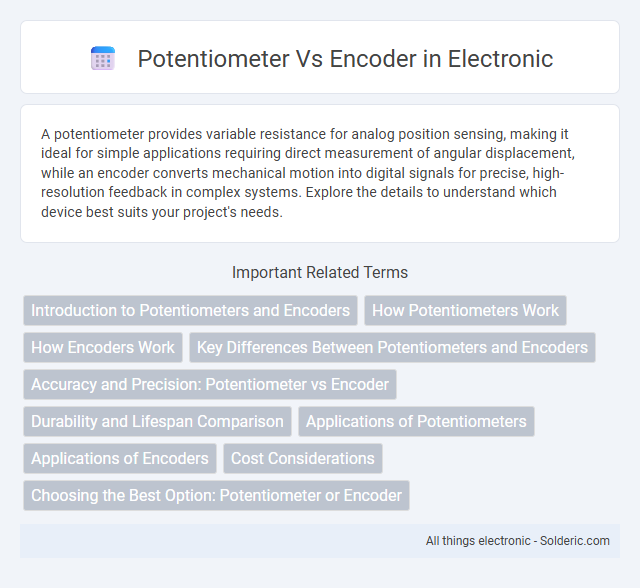A potentiometer provides variable resistance for analog position sensing, making it ideal for simple applications requiring direct measurement of angular displacement, while an encoder converts mechanical motion into digital signals for precise, high-resolution feedback in complex systems. Explore the details to understand which device best suits your project's needs.
Comparison Table
| Feature | Potentiometer | Encoder |
|---|---|---|
| Function | Measures angular or linear position as variable resistance | Measures position, speed, or direction digitally |
| Output Type | Analog voltage signal | Digital pulses or signals |
| Resolution | Low to moderate (depends on physical design) | High (depends on pulse count per revolution) |
| Durability | Limited lifespan due to mechanical wear | Long lifespan, minimal mechanical wear |
| Cost | Lower cost | Higher cost |
| Complexity | Simple design, easy integration | Complex electronics, requires signal processing |
| Applications | Volume control, simple position sensing | Robotics, industrial automation, precise motion tracking |
Introduction to Potentiometers and Encoders
Potentiometers are variable resistors used to measure angular or linear position by adjusting resistance output, commonly utilized in volume controls and position sensing. Encoders, either optical or magnetic, provide digital position feedback by converting motion into electronic signals, enabling precise measurement in robotics and automation. Both devices serve crucial roles in control systems, with potentiometers offering analog signals and encoders delivering high-resolution digital feedback.
How Potentiometers Work
Potentiometers operate by varying the resistance in an electrical circuit through a rotating or sliding contact, which adjusts the output voltage relative to the position of the wiper. This analog device converts mechanical displacement into a corresponding electrical signal, commonly used for measuring angular position or displacement. Unlike encoders that provide digital signals, potentiometers deliver continuous voltage levels proportional to their position, making them ideal for applications requiring precise variable voltage output.
How Encoders Work
Encoders function by converting angular or linear position into an electrical signal using optical or magnetic sensors that detect movement on a rotating disk or strip. Optical encoders use a light source and photodetector array to generate digital pulses corresponding to position changes, enabling precise measurement of speed and direction. This digital output contrasts with the analog voltage signal produced by potentiometers, offering higher accuracy and improved noise resistance in position sensing applications.
Key Differences Between Potentiometers and Encoders
Potentiometers measure angular or linear position by varying resistance, offering analog output, while encoders provide digital signals representing precise position or motion. Potentiometers are limited by mechanical wear and lower resolution, whereas encoders deliver higher accuracy and durability, suitable for complex applications. Your choice depends on the required precision level, environmental conditions, and signal type for optimal performance.
Accuracy and Precision: Potentiometer vs Encoder
Encoders generally offer higher accuracy and precision compared to potentiometers, with typical resolutions reaching thousands of pulses per revolution, enabling precise position feedback in industrial applications. Potentiometers provide analog position data but are limited by mechanical wear and lower resolution, often resulting in less consistent accuracy over time. Selecting an encoder over a potentiometer can significantly improve your system's performance where precise control and repeatability are critical.
Durability and Lifespan Comparison
Potentiometers typically have a shorter lifespan due to their mechanical wiper contacts that wear out over time, often lasting around 10,000 to 100,000 cycles. Encoders, especially optical or magnetic types, offer significantly higher durability and can endure millions of cycles with minimal maintenance. Your choice should consider the application's demand for longevity and reliability, where encoders generally provide superior durability compared to potentiometers.
Applications of Potentiometers
Potentiometers are widely used in applications requiring precise analog position sensing, such as volume controls in audio equipment, servo motor feedback, and adjustable power supplies. They offer simple and cost-effective solutions for measuring angular or linear displacement in industrial machinery and robotics. Their ability to provide continuous variable resistance makes them ideal for user interface devices like joysticks and throttle position sensors in automotive systems.
Applications of Encoders
Encoders are widely used in robotics, industrial automation, and CNC machines to provide precise position and speed feedback, enabling accurate control of motors and mechanical systems. Unlike potentiometers, which offer limited angular measurement, rotary and linear encoders deliver high-resolution digital signals essential for real-time motion control and automation processes. Your choice of encoders enhances system performance in applications requiring exact position sensing and reliable feedback.
Cost Considerations
Potentiometers generally offer lower upfront costs due to their simple design and widespread availability, making them a cost-effective choice for basic position sensing applications. Encoders, while typically more expensive initially, provide greater precision and durability, potentially reducing long-term maintenance and replacement expenses. Evaluating total cost of ownership requires considering both the initial investment and operational lifespan based on application requirements.
Choosing the Best Option: Potentiometer or Encoder
Selecting between a potentiometer and an encoder depends on the application's precision and feedback requirements; potentiometers offer simple, cost-effective analog position sensing ideal for basic angle measurement, while encoders provide high-resolution digital feedback suitable for precise motion control. Encoders excel in environments needing accurate speed, position, or direction data, supporting applications like robotics or CNC machines, whereas potentiometers are preferred for simpler, less demanding tasks. Evaluating factors like accuracy, durability, signal type, and environmental conditions ensures the optimal choice for efficient and reliable system performance.
potentiometer vs encoder Infographic

 solderic.com
solderic.com